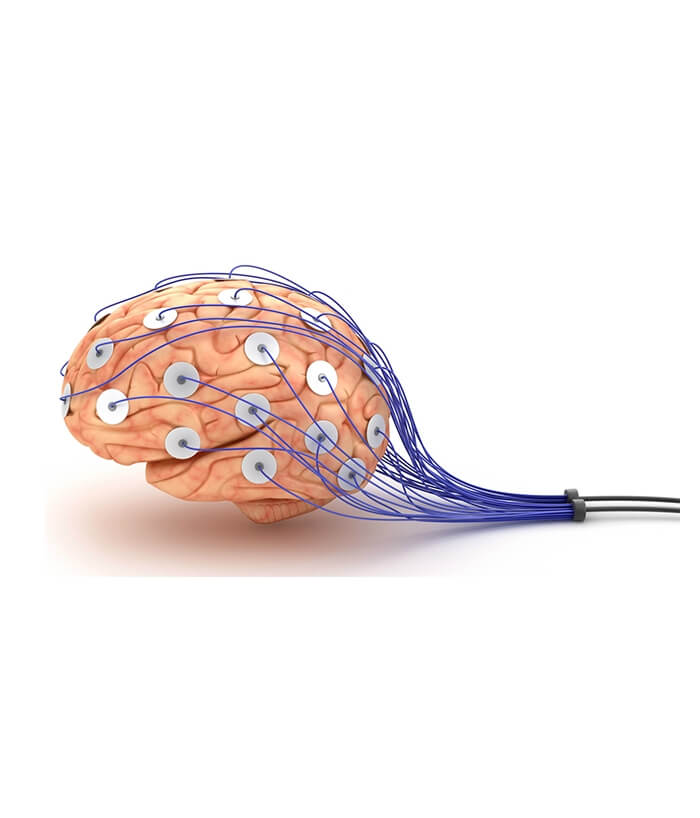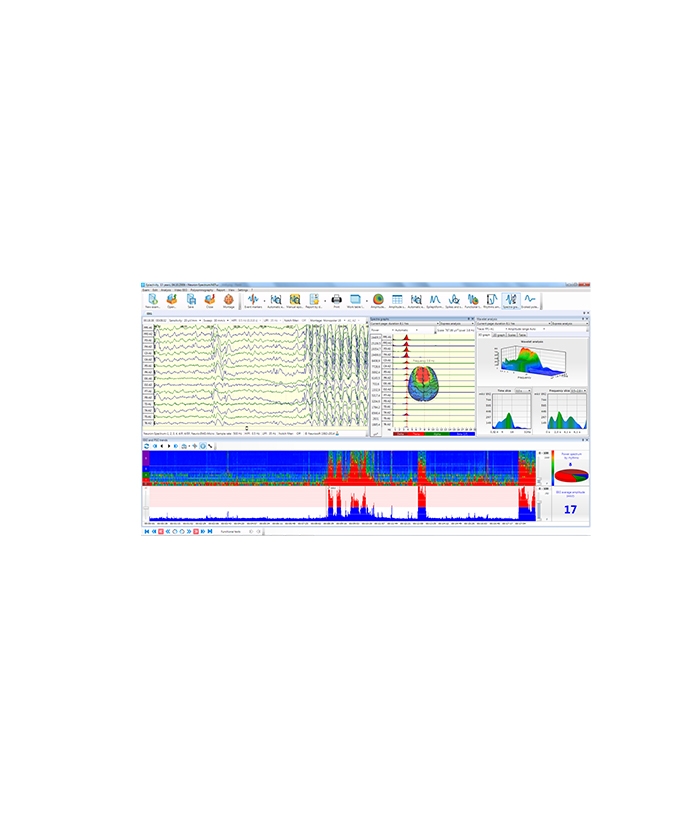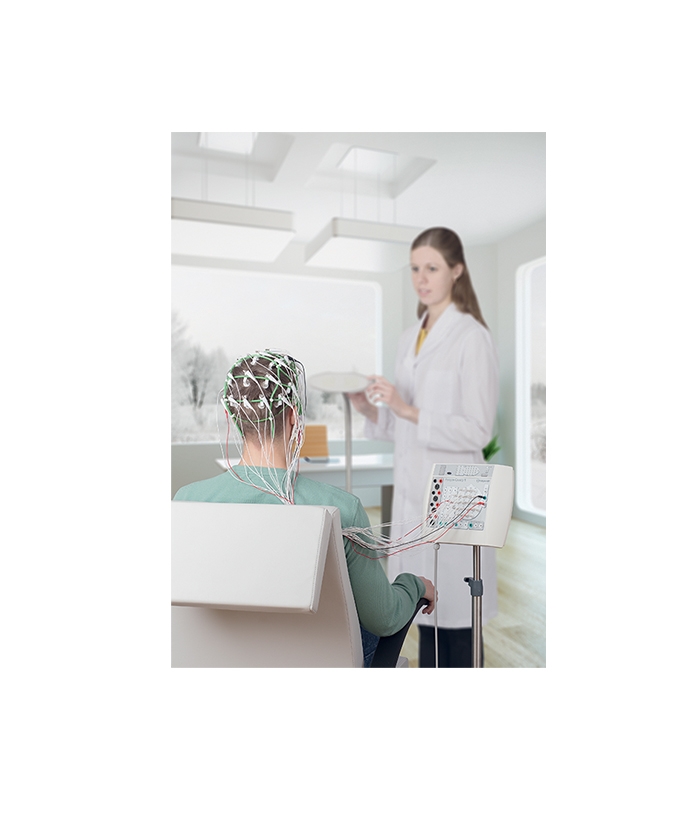.jpg)
What is an electroencephalogram?
An electroencephalogram is a medical technique for recording and interpreting the electrical activity of the brain. A series of electrodes are mounted on the scalp area. These electrodes collect the overall electrical activity that is transmitted to the surface of the brain, as a result of the electrical activity of neurons. The capture is done through these electrodes, coupled to a device called an electroencephalograph. Brain activity is based on connections and communication between neurons, which is achieved by transmitting small electrical signals, called electrical impulses. These create electrical potentials that are received by electrodes placed on the scalp, and the paths recorded on the electroencephalogram represent the variation of the potential differences between the pairs of electrodes selected by the examiner.
How do we prepare for the electroencephalogram?
The night before performing the electroencephalogram, it is recommended to wash your head because the layer of sebum that covers the scalp can act as an insulator, affecting the reception of the electrical signal. For the same reason, it is good not to apply conditioner or other hair treatments.
 |  |
Is the electroencephalogram painful?
The investigation is painless. The electrodes or a helmet with built-in electrodes are applied to the patient's scalp and collect the electrical activity of the brain that they transmit through the wires to the electroencephalograph.
What is a routine EEG recording?
You will be invited to sit on a chair or a bed, as relaxed as possible, motionless, with your eyes closed. The doctor will apply on your scalp the electrodes (small metal discs, conductors) that are connected by wires to the electroencephalograph. The role of the electroencephalograph is to amplify the electrical signal and to model it in paths that are subsequently analyzed on the monitor.
After the installation of the electrodes is finished, you must stay relaxed. The tighter you are, the shorter the recorded route will be. Most recording is done with the eyes closed, as light reduces the amplitude of waves in most healthy patients. It's best not to blink or grit your teeth.
After a few minutes you will be asked to breathe deeply and rhythmically for 3 minutes, sometimes longer (hyperventilation). The metabolic changes induced by this type of respiration stresses the brain, which can lead to important changes in the appearance of EEG recording (possibly normal before). At this stage, it is good not to move your head and not to swallow. After hyperventilation, also with your eyes closed, you will breathe normally, and the doctor will observe the recording (sometimes the EEG changes appear late during this period). In the end, intermittent light stimulation (SLI) is applied, which consists of exposing the light of a lamp with variable frequency. It is recommended not to avoid the light stimulus narrowing your eyes.
The movement of the head, eyes, swallowing, clenching of the teeth, or movement of the wires translate into electrical disturbances recorded graphically on the EEG as artifacts, which make interpretation difficult. For the same reason, you will be asked to turn off your mobile phone before registration.
 | .jpg) |
What is the duration of this procedure?
The standard duration is about 20 minutes without assembly but varies depending on the particularities of each case. You may be told to repeat a step such as hyperventilation, or some photostimulation for certain frequencies. When the recording is complete, the electrodes will be removed.
Electroencephalogram (EEG) is an important medical examination in the diagnosis of epilepsy. And it can be indicated in the diagnosis of delirium, fainting, craniocerebral trauma, tumors, brain infections, providing information about the existence and location of a brain injury, or the trigger for epileptic seizures.
The risks are minimal, but intermittent light stimulation or hyperventilation can cause epileptic seizures. Therefore, the examination is performed under the supervision of a doctor who can recognize the seizure and will immediately institute appropriate safety and therapeutic measures.
About Centrokinetic
Centrokinetic clinic offers all services necessary for a complete rehabilitation process, from the first consultation to the medical specialist to establish the correct diagnosis, to treatment and recovery.
Centrokinetic is the place where you will find clear answers and solutions for your motricity problems. The clinic is dedicated to osteoarticular conditions and is divided into the following departments:
- Orthopedics, a department composed of an extremely experienced team of orthopedic doctors, led by Dr. Andrei Ioan Bogdan, primary care physician in orthopedics-traumatology, with surgical activity at Medlife Orthopedic Hospital, specialized in sports traumatology and ankle and foot surgery.
- Pediatric orthopedics, where children's sports conditions are treated (ligament and meniscus injuries), spinal deformities (scoliosis, kyphosis, hyperlordosis) and those of the feet (hallux valgus, hallux rigidus, equine larynx, flat valgus, hollow foot).
- Neurology, which has an ultra-performing department, where consultations, electroencephalograms (EEG) and electromyography (EMG) are performed.
- Medical recovery for adults and children, department specialized in the recovery of performance athletes, in spinal disorders, in the recovery of children with neurological and traumatic diseases. Our experience is extremely rich, treating over 5000 performance athletes.
- Medical imaging, the clinic being equipped with ultrasound and MRI, high-performance devices dedicated to musculoskeletal disorders, and complemented by an experienced team of radiologists: Dr. Sorin Ghiea and Dr. Cosmin Pantu, specialized in musculoskeletal imaging.
Find the latest news by following the Facebook, Instagram and YouTube accounts of the Centrokinetic clinic.
Prices
You can find here a detailed list of the prices of individual services. But any correct recovery process is based on a mixed plan of therapies and procedures, customized according to the condition, stage of the condition, patient profile, and other objective medical factors. As a result, in order to configure a treatment plan, with the therapies involved and the prices related to the plan, please make an appointment here for an initial consultation.
MAKE AN APPOINTMENT
FOR AN EXAMINATION
See here how you can make an appointment and the location of our clinics.
MAKE AN APPOINTMENT

































































































































